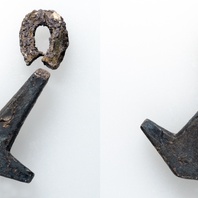
Viking Objects
Thor’s Hammer Pendant (1989-59/7224)
A silver hammer-shaped pendant found in Grave 511 at Repton. This is the grave of a man who appears to have died violently, taking a vicious cut to his loins. These may have been worn to show devotion to the god Thor, or to secure the god’s protection, although there is little evidence to support this interpretation. Pendants like this have been found made of lead, copper alloy, silver and gold, showing that many different strata of society could have worn them.
Read More
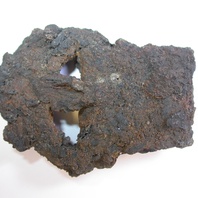
Viking Objects
Iron Buckle (1985/225-8)
An iron buckle found in Mound 6 at Heath Wood, Ingleby, Derbyshire. It is one of two iron buckles found in this burial mound together with a small number of bronze fragments and iron nails. This buckle has parallels in Scandinavia.
Read More
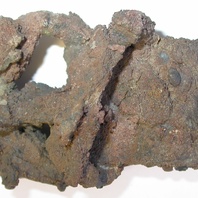
Viking Objects
Iron Buckle (1988/225-9)
An iron buckle found in Mound 6 at Heath Wood, Ingleby, Derbyshire. It is one of two iron buckles found in this burial mound together with a small number of bronze fragments and iron nails. This buckle features a strap slide secured between the backplate and two terminal rivets.
Read More
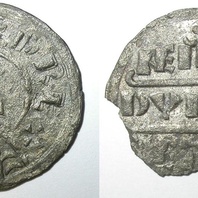
Viking Objects
Coin of Alfred the Great (1989-58/3381)
This silver penny from the mass grave at Repton was minted by a moneyer called Dudwine in Canterbury for Alfred the Great. Alfred was King of Wessex from 871 to 899 and spent most of his reign fighting off Viking invasions. He won a decisive victory at the Battle of Edington in 878 which resulted in a peace with the Vikings and the creation of the Danelaw. Minting coins was a way of controlling the means of exchange within a kingdom and which created a more easily administered standardized system of trade. Moreover, the coins themselves were often used as propaganda, portaying symbols and statements that gave off a desired message. The Vikings later used the minting of coins to legitimize their own rule.
Read More
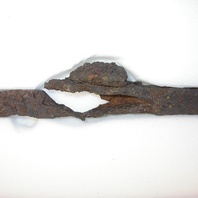
Viking Objects
Sword Fitting (1985/225-13)
This is the lower guard of a sword that may have been a Petersen Type H sword with triangular pommel. This style of sword is the most common type found in Norway and accounts for approximately 25% of those found in Ireland. It was found about 760mm from an iron sword blade in Mound 7, along with iron nails and a fragment of a possible iron spur.
Read More
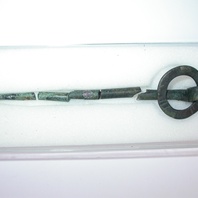
Viking Objects
Ring-headed Pin (2004-311-sf245)
This ring-headed pin was uncovered in a cremation burial which was generally unfurnished and containing little evidence. This type of pin was fairly common throughout the Viking Age and was used to hold a cloak around one’s body.
Read More
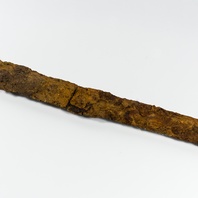
Viking Objects
Sword (1989-59/7113)
This Viking Age sword was found in Grave 511 at Repton where the invading Viking Great Army had their winter camp in 873/4. When it was found, the sword had traces of a wooden scabbard attached to the rusted blade. Analysis showed that the scabbard was lined with fleece and covered in leather. The grip was wooden and covered in a woollen textile.
Read More
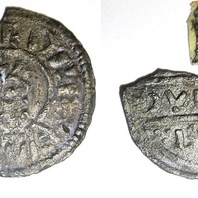
Viking Objects
Coin of Burghred of Mercia (1989-58/3650)
A silver penny of Burghred of Mercia, found in the mass grave at Repton, minted by the moneyer Dudwine. Dudwine may be the same moneyer who was minting coins for Alfred the Great at a later date. Burghred was king of Mercia from 852-874 CE. He was driven out of Mercia by the Vikings during their march from Lindsey to Repton in 874 after they sacked Tamworth. Burghred fled to Rome, where he eventually died, and was replaced by Ceowulf II who was loyal to the Vikings. Minting coins was a way of controlling the means of exchange within a kingdom and which created a more easily administered standardized system of trade. Moreover, the coins themselves were often used as propaganda, portaying symbols and statements that gave off a desired message. The Vikings later used the minting of coins to legitimize their own rule.
Read More
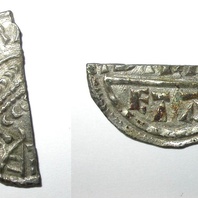
Viking Objects
Coin of Burghred of Mercia (1989-58/3723)
A silver penny of Burghred of Mercia, found in the mass grave at Repton, minted by the moneyer Dudda, probably in London. Burghred was king of Mercia from 852-874 CE. He was driven out of Mercia by the Vikings during their march from Lindsey to Repton in 874 after they sacked Tamworth. Burghred fled to Rome, where he eventually died, and was replaced by Ceowulf II who was loyal to the Vikings. Minting coins was a way of controlling the means of exchange within a kingdom and which created a more easily administered standardized system of trade. Moreover, the coins themselves were often used as propaganda, portaying symbols and statements that gave off a desired message. The Vikings later used the minting of coins to legitimize their own rule.
Read More
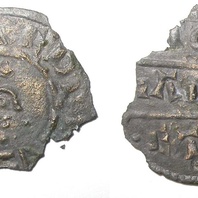
Viking Objects
Coin of Aethelred (1989-58/3395)
A silver penny of Aethelred I of Wessex was found in the mass grave at Repton and minted by a moneyer apparently called Liabinc. The location of minting is unknown. Aethelred I was King of Wessex from 865 until his death in 871. Aethelred’s reign coincided with the arrival of the Viking Great Heathen Army in England and he fought them with little success during their invasion of Wessex which began in 870. After his death, he was succeeded by his youngest brother, Alfred the Great, who carried on the war with the Vikings. Minting coins was a way of controlling the means of exchange within a kingdom and which created a more easily administered standardized system of trade. Moreover, the coins themselves were often used as propaganda, portraying symbols and statements that gave off a desired message. The Vikings later used the minting of coins to legitimize their own rule.
Read More
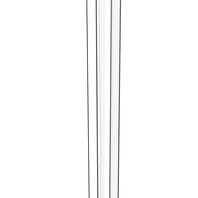
Viking Designs
Drawing of a Viking Sword
This is a drawing of a Viking Age sword which was found in Grave 511 at Repton where the invading Viking Great Army had their winter camp in 873/4. When it was found, the sword had traces of a wooden scabbard attached to the rusted blade. Analysis showed that the scabbard was lined with fleece and covered in leather. The grip was wooden and covered in a woollen textile.
